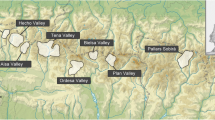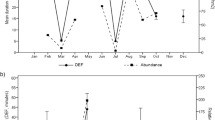Abstract
The authors monitored five maternity colonies of Plecotus austriacus to obtain data about phenology, roosting, and emergence behaviour. The bats occupied their roosts between April and October, with maximum colony sizes in August. Roosting sites in the attic’s roof ridge and temperatures of 20–25°C were favoured. Also considering the small colony (maximum 59) and cluster sizes (maximum 13 bats), P. austriacus behaved less thermophilic than other attic-dwelling species. During low temperatures, the bats chose small crevice-like roosting sites to compensate for that; during daytime, many bats remained hidden in crevices. Emergence began approximately 30 min after sunset; the bats used multiple, preferably crevice-like openings. P. austriacus left its summer roosts comparatively late; renovation works should, therefore, not start before November. For monitoring purposes, we recommend two to three emergence countings outside the attics in early August during warm weather, alongside two attic inspections 1–2 h before emergence for offspring monitoring.






Similar content being viewed by others
References
Audet D (1992) Roost quality, foraging and young production in the mouse-eared bat Myotis myotis: a test of the ESS model of group size selection. Ph.D. Diss., York Univ., Ontario
Audet D, Fenton MB (1988) Heterothermy and the use of torpor by the bat Eptesicus fuscus (Chiroptera: Vespertilionidae): a field study. Physiol Zool 61:197–204
Bauerova Z (1980) Contribution to the trophic ecology of the grey long-eared bat, Plecotus austriacus. Folia Zool 31(2):113–122
Bontadina F, Schofield H, Naef-Daenzer B (2002) Radio-tracking reveals that lesser horseshoe bats (Rhinolophus hipposideros) forage in woodland. J Zool Lond 258:281–290
Braun M, Häussler U (2003) Graues Langohr Plecotus austriacus (Fischer 1829). In: Braun M, Dieterlen F (eds) Die Säugetiere Baden-Württembergs Band 1. Eugen Ulmer, Stuttgart, pp 474–483
Bundesamt für Naturschutz (1998) Rote Liste gefährdeter Tiere Deutschlands. Schriftenr Landschpfl Naturschutz 55:434pp
Flückinger FP, Beck A (1995) Observations on the habitat use for hunting by Plecotus austriacus (Fischer 1829). Myotis 32(33):121–122
Friemel D, Zahn A (2004) Wimperfledermaus (Myotis emarginatus). In: Bayerisches Landesamt für Umweltschutz (ed) Fledermäuse in Bayern. Eugen Ulmer, Stuttgart, pp 166–176
Fuhrmann M (1994) Graues Langohr, Plecotus austriacus (Fischer 1829). In: Arbeitsgemeinschaft für Fledermausschutz in Hessen (ed) Die Fledermäuse Hessens. Manfred Hennecke, Remshalden-Buoch, pp 74–75
Güttinger R, Zahn A, Krapp F, Schober W (2001) Myotis myotis—Großes Mausohr. In: Krapp F (ed) Handbuch der Säugetiere Europas Band 4. Fledertiere, Teil 1. Chiroptera 1, Aula, Wiebelsheim, pp 123–207
Haensel J, Rackow W (1996) Fledermäuse als Verkehrsopfer—ein neuer Report. Nyctalus 6(1):29–47
Hanak V (1969) Ökologische Bemerkungen zur Verbreitung der Langohren (Gattung Plecotus Geoffroy 1818) in der Tschechoslowakei. Lynx 6:57–66
Horácek I (1975) Notes on the Ecology of Bats of the Genus Plecotus (Geoffroy 1818) (Mammalia: Chiroptera). Vest Cs Spolia Zool 39(3):195–210
Horácek I (1981) Comparative notes on the population structure in several European bat species. Myotis 18(19):8–53
Horácek I, Dulic B, Bogdanowicz (2004) Plecotus austriacus (Fischer 1829)—Graues Langohr. In: Niethammer J, Krapp F (eds) Handbuch der Säugetiere Europas 4: Fledertiere, Teil II: Chiroptera II. Eugen Ulmer, Kempten, pp 1001–1049
Kayikcioglu A, Zahn A (2004) High temperatures and the use of satellite roosts in Rhinolophus hipposideros. Mammalian Biology (Z f Säugetierkd) 69:337–341
Kiefer A (1996) Untersuchungen zu Raumbedarf und Interaktionen von Populationen des Grauen Langohrs (Plecotus austriacus FISCHER, 1829) im Naheland. Diploma Thesis, Johannes-Gutenberg-Univ, Mainz
Kiefer A, Veith M (1998a) Untersuchungen zu Raumbedarf und Interaktionen von Populationen des Grauen Langohrs, Plecotus austriacus (Fischer 1829), im Nahegebiet. Nyctalus 6(5):531
Kiefer A, Veith M (1998b) Saisonale thermoregulatorische Hangplatzwahl in einem Sommer- und Winterquartier beim Grauen Langohr, Plecotus austriacus (Fischer 1829) (Chiroptera, Vespertilionidae). Nyctalus 6(5):532
Kiefer A, Merz H, Rackow W, Roer H, Schlegel D (1994) Bats as traffic casualties in Germany. Myotis 32:215–220
König C, König J (1961) Zur Ökologie und Systematik südfranzösicher Fledermäuse. Bonner zool Beitr 12:189–229
Krull D, Schumm A, Metzner W, Neuweiler G (1991) Foraging areas and foraging behaviour in the notch-eared bat Myotis emarginatus (Vespertilionidae). Behav Ecol Sociobiol 28:247–253
Rudolf BU (2004) Graues Langohr Plecotus austriacus (Fischer 1829). In: Meschede A, Rudolph BU (eds) Fledermäuse in Bayern. Eugen Ulmer, Stuttgart, pp 333–339
Stebbings RE (1970) A comparative study of Plecotus auritus and Plecotus austriacus (Chiroptera, Vespertilionidae) inhabiting one roost. Bijdr Dierkde 40(1):91–94
Steinborn G (1984) Graues Langohr - Plecotus austriacus (Fischer 1829). In: Schröpfer R, Feldmann R, Vierhaus H (eds) Die Säugetiere Westfalens. Abh Westf Mus Naturkd Münster 46(4):116–119
Tuttle MD, Stevenson D (1982) Growth and survival of bats. In: Kunz TH (ed) Ecology of bats. Plenum Press, New York, pp 105–150
Zahn A, Henatsch B (1998) Bevorzugt Myotis emarginatus kühlere Wochenstubenquartiere als Myotis myotis? Mammalian Biology (Z f Säugetierkd) 63:26–31
Zahn A, Weiner P (2004) Kleine Hufeisennase (Rhinolophus hipposideros). In: Bayerisches Landesamt für Umweltschutz (ed) Fledermäuse in Bayern. Eugen Ulmer, Stuttgart, pp 111–126
Acknowledgements
The authors wish to thank Mrs. Strasser, Mr. and Mrs. Heiger, Mr. Flammensbeck, Mrs. Mayr and Mrs. Angermaier, the sacristans of the parishes hosting the five monitored maternity colonies of Plecotus austriacus, for kindly providing all help required for the realisation of this study. Furthermore, we would like to thank Frank Arnoldi and Dr. Manfred Scheunert for their help with the counts inside and outside the attics, as well as Dr. Ryan Oyama for proofreading the English version of the manuscript.
Author information
Authors and Affiliations
Corresponding author
Additional information
Communicated by H. Kierdorf
Rights and permissions
About this article
Cite this article
Scheunert, A., Zahn, A. & Kiefer, A. Phenology and roosting habits of the Central European grey long-eared bat Plecotus austriacus (Fischer 1829). Eur J Wildl Res 56, 435–442 (2010). https://doi.org/10.1007/s10344-009-0333-9
Received:
Revised:
Accepted:
Published:
Issue Date:
DOI: https://doi.org/10.1007/s10344-009-0333-9




